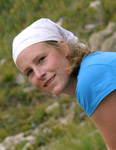 |
Alumna Katharina Fuchs (Germany, 1985) Dipl.-Prähist. in Pre- and Protohistory, Anthropology and Zoology |
|---|---|
| PhD project |
|
| Research interests | Physical and Prehistoric Anthropology, Palaeopathology, Bioarchaeology, Palaeodiet and Subsistence Strategies, Population Processes; Funeral Archaeology, Social organisation and development of past societies |
| Education |
Since April 2013 June 2010 2006/07 October 2004 |
| Work experience |
May, July - August 2012; January 2013 October 2010 – March 2012 July - August 2011 September 2010 June - July 2010 February 2010 March 2009 2007 - 2009 September 2006 - 2008 August 2005 |
| Selected publications |
forthcoming forthcoming forthcoming in Press |
| Memberships |
The Paleopathology Association (PPA) Gesellschaft für Archäozoologie und Prähistorische Anthropologie e. V. (GAPA) Gesellschaft für Anthropologie (GfA) |

